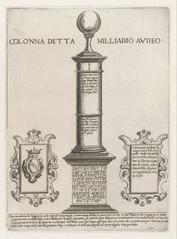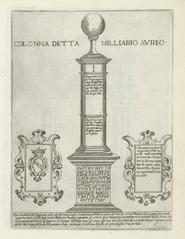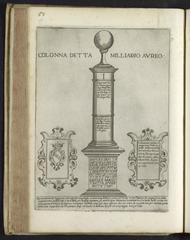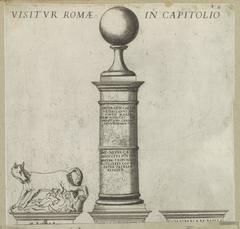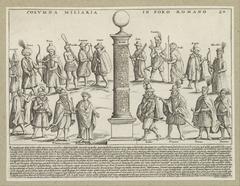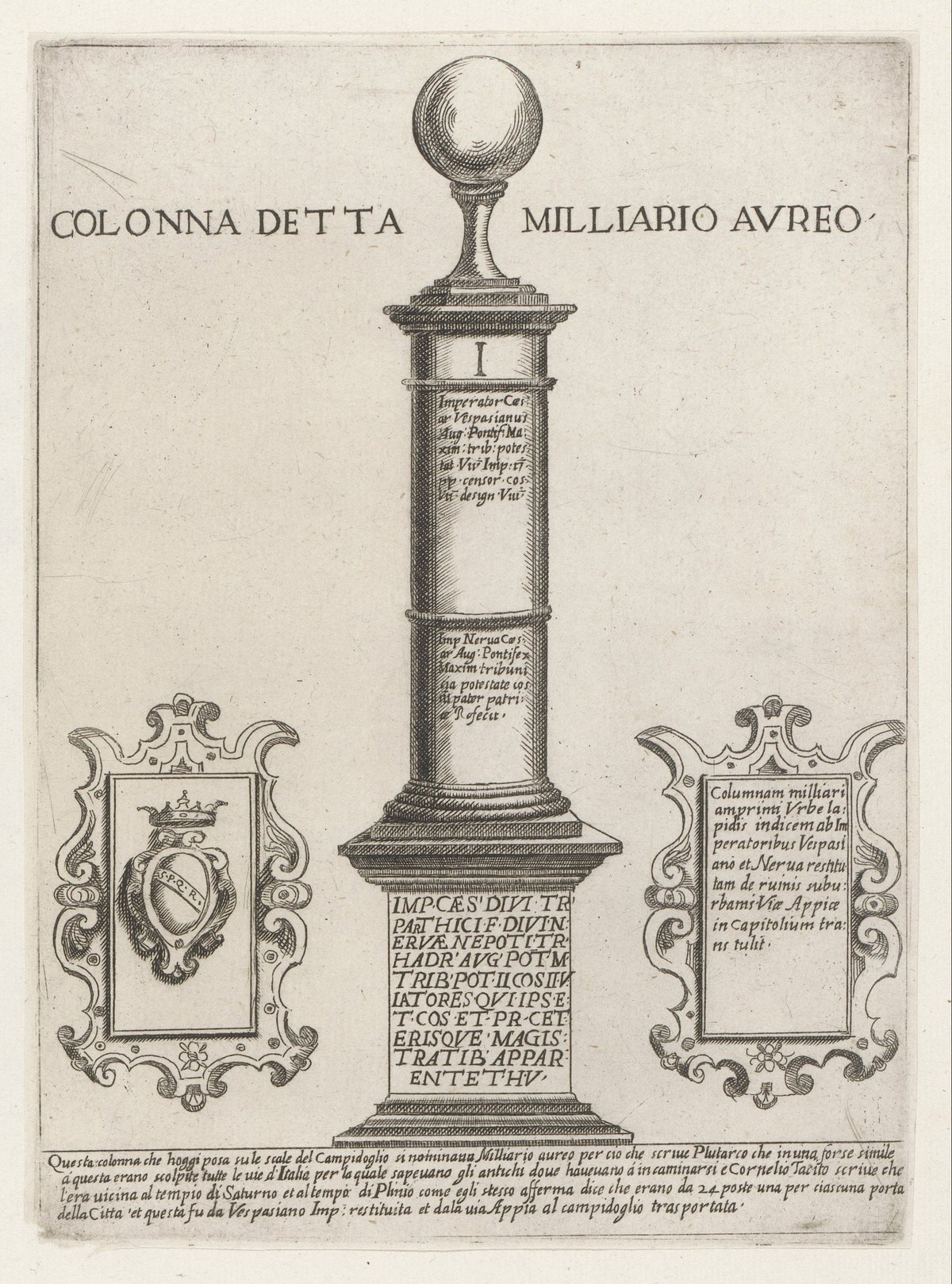
Milliarium Aureum Visiting Hours, Tickets, and Rome Historical Sites Guide
Date: 14/06/2025
Introduction
The Milliarium Aureum—known as Rome’s “Golden Milestone”—is a foundational symbol of the Roman Empire’s infrastructure and administrative prowess. Erected by Emperor Augustus around 20 BCE, it served as the starting point from which all roads of the empire were measured, giving real meaning to the phrase “all roads lead to Rome.” Located within the Roman Forum near the Temple of Saturn, the site offers a direct connection to the logistical and cultural heart of ancient Rome. Though only fragments remain today, the Milliarium Aureum’s legacy endures as a testament to Roman unity, engineering, and influence.
This comprehensive guide details everything you need to plan your visit: historical context, ticketing and opening hours, accessibility, nearby attractions, practical travel tips, and answers to frequently asked questions. Whether you are a history enthusiast or a casual traveler, this guide will help you appreciate the significance of the Milliarium Aureum and enhance your experience in Rome.
(The Byzantine Legacy, ItalyGuides, Official Rome Tourism)
Table of Contents
- Introduction
- Origins and Historical Significance
- Architectural Features and Archaeological Highlights
- Visiting the Milliarium Aureum: Location, Hours, and Tickets
- Travel Tips and Accessibility
- Nearby Attractions and Photo Opportunities
- Frequently Asked Questions (FAQ)
- Visuals and Media Suggestions
- Conclusion and Final Thoughts
- References and Further Reading
Origins and Historical Significance
The Milliarium Aureum was commissioned by Emperor Augustus in 20 BCE as the symbolic “point zero” of the Roman road network. Located near the Temple of Saturn in the Roman Forum, it was the reference point for measuring distances to the empire’s major cities, thus embodying the centralized power and unity of Rome. The monument’s role extended beyond logistics; it was a visible assertion of Rome’s reach and authority across three continents.
The phrase “all roads lead to Rome” stems directly from this site, which not only functioned as a physical marker but also as a statement of Rome’s imperial ideology. The establishment of the Milliarium Aureum reinforced the administrative efficiency and cohesion that allowed Rome’s vast territories to be governed effectively. Its influence even extended to later empires, inspiring similar monuments such as Constantinople’s Milion. (ItalyGuides)
Architectural Features and Archaeological Highlights
Physical Description and Materials
The original Milliarium Aureum was likely a cylindrical marble column about 3.7 meters (12 feet) tall and 1.15 meters (3.8 feet) in diameter, possibly sheathed in gilded bronze. Archaeological finds near the Temple of Saturn include a marble shaft with traces of bronze and a circular marble plinth, although some fragments may belong to the nearby Umbilicus Urbis. No direct inscriptions survive, but it is believed the column featured bronze plaques listing major cities and distances from Rome.
Construction and Techniques
The monument was set on a concrete base and used bronze hooks to secure its gilded covering, underscoring its symbolic importance. Excavations in 1959 uncovered a circular base thought to be the foundation of the Milliarium Aureum, but scholarly debate continues due to overlapping remains and ancient map gaps.
Symbolic Legacy
The Milliarium Aureum was not just an engineering landmark—it was the very heart of the empire’s road system, central to the cursus publicus, the Roman state’s courier and transport service. Its proximity to iconic sites such as the Rostra and the Temple of Saturn further links it to Rome’s political, religious, and cultural life. (The Byzantine Legacy)
Visiting the Milliarium Aureum: Location, Hours, and Tickets
Location
The Milliarium Aureum stands at the northwest corner of the Temple of Saturn, within the Roman Forum archaeological park, close to the Capitoline Hill. The site is marked by a modest circular marble base and an informational plaque. Main Forum entrances provide ticketed access. (Waymarking.com)
Visiting Hours (2025)
- April–October: 8:30 AM – 7:15 PM (last entry 6:15 PM)
- November–March: 8:30 AM – 4:30 PM (last entry 3:30 PM)
- Check for special event adjustments (e.g., Jubilee Year 2025).
Ticket Information
- Standard ticket: €16 (includes Roman Forum, Colosseum, and Palatine Hill)
- Reduced ticket: €2 (EU citizens aged 18–25)
- Free entry: Under 18 and other qualifying categories
- Purchase: Advance online booking is essential during high-traffic periods like the Jubilee.
Consider city passes for skip-the-line access and transit perks. (Visit Italy)
Travel Tips and Accessibility
- Best time to visit: Early morning or late afternoon for fewer crowds and softer lighting.
- Jubilee Year 2025: Expect heavy crowds from late April to June and in October; book tickets in advance and plan accordingly.
- Accessibility: The Forum features uneven ground and ancient paving. Wheelchair assistance is available at main entrances, but some areas are challenging—comfortable shoes are a must. (Official Rome Tourism Accessibility)
- Amenities: Restrooms at entrances, limited shade; bring water.
Nearby Attractions and Photo Opportunities
The Milliarium Aureum’s location in the Roman Forum places it near:
- Temple of Saturn: Adjacent ancient temple.
- Arch of Septimius Severus: Triumphal arch.
- Rostra: Historic speaker’s platform.
- Capitoline Hill: Offers panoramic city views and museums.
For photography, the early morning provides optimal conditions, with the ruins of the Temple of Saturn and the Arch of Septimius Severus serving as impressive backdrops.
Frequently Asked Questions (FAQ)
Q: What are the visiting hours for the Milliarium Aureum?
A: The site follows Roman Forum hours: 8:30 AM to sunset (seasonal variations).
Q: Do I need a separate ticket to visit the Milliarium Aureum?
A: No, it is included with the Roman Forum entry ticket.
Q: Is the site accessible for people with disabilities?
A: The terrain is uneven, but accessibility services are available at Forum entrances.
Q: Are guided tours available?
A: Yes, many guided and audio tours include the Milliarium Aureum.
Q: Can I take photos at the site?
A: Yes, photography is permitted.
Visuals and Media Suggestions
- Add high-quality images of the Milliarium Aureum’s marble fragments with alt text (e.g., “Milliarium Aureum base in the Roman Forum”).
- Include a map highlighting the monument’s location within the Forum.
Conclusion and Final Thoughts
Despite the modest remains, the Milliarium Aureum remains an enduring symbol of Rome’s administrative genius and its central role in world history. Visiting the site in 2025, especially during the Jubilee Year, requires advance planning for tickets and optimal timing. Engage with audio guides or expert-led tours for deeper context, and explore nearby attractions to gain a holistic view of Rome’s ancient heart.
For an enriched visit, download the Audiala app for audio tours and maps, and stay updated through official tourism channels and social media. The Milliarium Aureum is more than a relic—it is a gateway to understanding how infrastructure, unity, and symbolism shaped the Roman world and continue to influence urban identity today.
